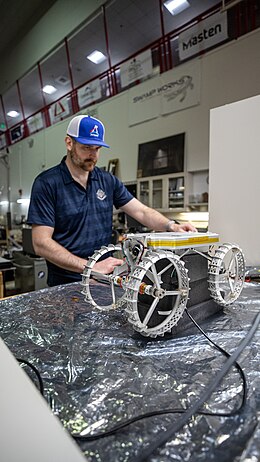 Astrobotic's CubeRover | |
| Mission type | Technology demonstrator |
|---|---|
| Operator | Astrobotic Lab and Carnegie Mellon University |
| Website | www |
| Spacecraft properties | |
| Spacecraft | Iris[1][2] |
| Spacecraft type | Robotic lunar rover |
| Bus | CubeRover |
| Start of mission | |
| Launch date | 8 January 2024 07:18:36 UTC |
| Rocket | Vulcan Centaur VC2S |
| Launch site | Cape Canaveral SLC-41 |
| Contractor | United Launch Alliance |
| Moon rover | |
| Landing date | 23 February 2024 (originally planned) |
| Landing site | Planned: Mons Gruithuisen Gamma |
| Transponders | |
| Band | Wi-Fi |
| Instruments | |
| Two cameras with 1936 × 1456 resolution | |
CubeRover is a class of planetary rover with a standardized modular format meant to accelerate the pace of space exploration. The idea is equivalent to that of the successful CubeSat format, with standardized off-the-shelf components and architecture to assemble small units that will be all compatible, modular, and inexpensive.[3]
The rover class concept is being developed by Astrobotic Technology in partnership with Carnegie Mellon University, and it is partly funded by NASA awards.[3] A Carnegie Mellon University initiative - completely independent of NASA awards - developed Iris, the first flightworthy CubeRover. It was launched on 8 January 2024 along with Peregrine Mission One.[4] Surface operations phased out along with landing of Peregrine lander due to excessive propellant leak.[5]
- ^ "Iris Lunar Rover". Carnegie Mellon University's Robotics Institute.
- ^ Carnegie Mellon Unveils Lunar Rover "Iris". Carnegie Mellon University's Robotics Institute.
- ^ a b Campbell, Lloyd (18 March 2018). "Astrobotic wins NASA award to produce small lunar rover". Spaceflight Insider. Archived from the original on 2019-08-14.
- ^ Belam, Martin (2024-01-08). "Nasa Peregrine 1 launch: Vulcan Centaur rocket carrying Nasa moon lander lifts off in Florida – live updates". the Guardian. ISSN 0261-3077. Retrieved 2024-01-08.
- ^ Wattles, Jackie; Fisher, Kristin (2024-01-08). "Peregrine mission abandons moon landing attempt after suffering 'critical' fuel loss". CNN. Retrieved 2024-05-17.